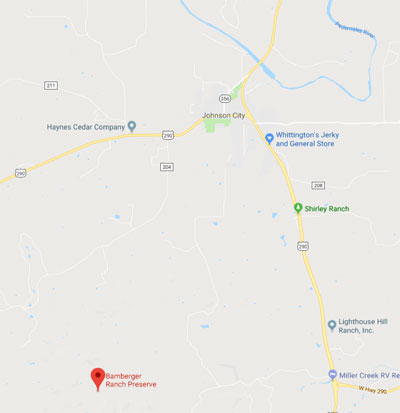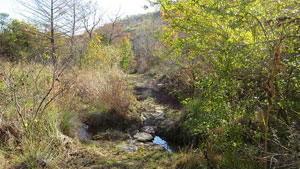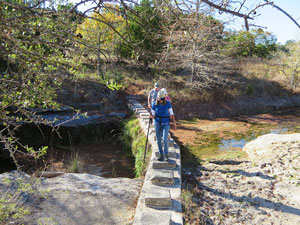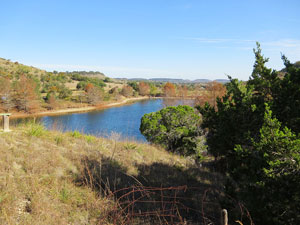In 1969, a wealthy visionary named J. David Bamberger — co-founder of Church’s Chicken — bought 3,000 acres of land in the Texas Hill Country a few miles south of Johnson City. Over the next few years, he increased the size of the ranch to its present 5,500 acres. In 2002, the Bamberger Ranch Preserve was created as a private operating foundation, and serves to maintain the ranch as a research and educational resource to illustrate the importance of preserving the original natural habitat of the Hill Country.

 Using proven grassland management practices, the ranch has reintroduced native plant species, while removing non-native invasive species. This process significantly reduced rainfall runoff, which in turn allowed the numerous long-dormant springs in the area to recharge and once again begin to flow. The result is a spectacularly biodiverse environment.
Using proven grassland management practices, the ranch has reintroduced native plant species, while removing non-native invasive species. This process significantly reduced rainfall runoff, which in turn allowed the numerous long-dormant springs in the area to recharge and once again begin to flow. The result is a spectacularly biodiverse environment.
The ranch is open to the public for periodic self-guided group hikes, as well as for various educational and research programs. My wife and I were fortunate to be invited by our good friends to accompany them on one such hike last November.
 Five well-maintained trails totaling about four miles wind through the ranch, most of them named after famous conservationists and environmentalists such as Jane Goodall, Rachel Carson, and Ferdinand Lindheimer (aka the Father of Texas Botany). The trails involve some climbing, but nothing very steep, and some occasional loose rocks to traverse, but overall the hiking is easy.
Five well-maintained trails totaling about four miles wind through the ranch, most of them named after famous conservationists and environmentalists such as Jane Goodall, Rachel Carson, and Ferdinand Lindheimer (aka the Father of Texas Botany). The trails involve some climbing, but nothing very steep, and some occasional loose rocks to traverse, but overall the hiking is easy.
The day was cool, clear, and slightly breezy when we set out. There were about thirty hikers, including one couple with two young children. We were shuttled through the ranch for a quick introduction, and the resident biologist pointed out various sites of special interest, including the chiroptorium…a manmade bat cave housing a migratory population of more than a million Mexican free-tailed bats — the state flying mammal of Texas (I doubt there was a lot of competition for the title).
The chiroptorium was built in 1998, but researchers were puzzled by the relative lack of bats residing there. They finally determined that the problem was the three large plate glass windows installed in one wall to allow observation of the residents. The bats’ sonar apparently had trouble distinguishing the glass from the outdoors and they kept colliding with the windows. Once the windows were covered, the bat population grew quickly. (Visit this page for more about the chiroptorium.)
We decided to hike almost the entirety of the trail system, since we weren’t sure when we might be able to return. The fall foliage was striking in places, and we met up with the biologist on the trail and peppered him with a mess of questions about what we had seen along the way. I learned that I should never phrase a question to an expert thusly: “Now, isn’t this tree a _____?” After three consecutive incorrect observations, I finally started just pointing and asking “What is that?”
We particularly enjoyed the sections of the trail that paralleled Miller Creek. The spring-fed creek flows into the small Madrone Lake, and eventually meets up with the Pedernales River. The creek wasn’t flowing particularly swiftly due to the ongoing drought, but the water was clear and the occasional small waterfalls made a pleasant soundtrack for the scenery.
 We were a bit disappointed that we didn’t see much animal life during the four hour hike. It was too cool for snakes, and perhaps we were too noisy or unobservant to see the any of the 28 species of mammals that have been sighted on the ranch. We did see a wild turkey. Well, to be precise, we saw the remains of a wild turkey at the edge of a pond. We notified the biologist (in keeping with my campaign of disinformation, I told him it was a hawk), and he later informed us that a predator of some kind had gutted it and left the carcass where we spotted it.
We were a bit disappointed that we didn’t see much animal life during the four hour hike. It was too cool for snakes, and perhaps we were too noisy or unobservant to see the any of the 28 species of mammals that have been sighted on the ranch. We did see a wild turkey. Well, to be precise, we saw the remains of a wild turkey at the edge of a pond. We notified the biologist (in keeping with my campaign of disinformation, I told him it was a hawk), and he later informed us that a predator of some kind had gutted it and left the carcass where we spotted it.
I highly recommend a visit to Selah if you’re in the vicinity during a scheduled hike. It’s a testament to the ability of man to be a positive influence on the environment, and I’m thankful someone had the vision and the resources to provide such a gift to the rest of us.
I assembled a short video of footage and photos from our hike. I’ve also embedded a more professional video (also found on the Bamberger website, linked at the beginning of this post) that explains in more detail how the project affected the groundwater in the area. It’s a fascinating account.
Selah: Water from Stone from Fin & Fur Films on Vimeo.
Discover more from The Fire Ant Gazette
Subscribe to get the latest posts sent to your email.
